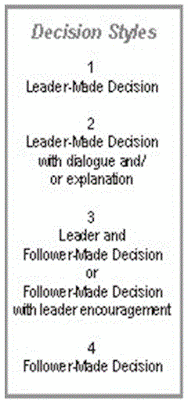Teaching/Leadership style can dictated by understanding the learners competency and by the dynamics of the situation. While athletes progress through the 3 stages of learning they become increasingly competent. Learning is a maturing process and each phase of learning and maturity there is a leading style that produces the strongest results. The "X" factor in coach and teaching is referent power. Referent power is power of an individual over the followers based on the quality of leader member relations. If the leader trusted, admired, and or respect you have rederent power. The best teachers and coaches have good working relationships with their students. Leadership stratagies can be enhanced by understanding the relationship between your approach and the phases of learning your follower is in. They are also enhanced when we consider the impact of leader/follower dynamics. Understanding of your situation is the key for selecting the manner in which to lead or supervise. Here are some leadership models that include criteria that can help you better undertsand the situation you face.
Situational favorableness: Understanding the role you need to play
According to Fiedler, there is no ideal leader. Both task-oriented and relationship-oriented leaders can be effective if their leadership orientation fits the situation. The contingency theory allows for predicting the characteristics of the appropriate situations for effectiveness. Three situational components determine the favorableness of situational control:
- Leader-Member Relations, referring to the degree of mutual trust, respect and confidence between the leader and the subordinates.
- Task Structure, referring to the extent to which group tasks are clear and structured.
- Leader Position Power, referring to the power inherent in the leader's position itself.
The role of the leader is most simplisticly broken down into two roles:
Task Leader – The leaders effort is being used to directly influence the business at hand, making group tasks are clear and orderly
People Leader – The leader’s effort is used to support individual needs. Build relationships of mutual trust, respect, and confidence between the leader and the subordinates
When there is a good leader-member relation, a highly structured task, and high leader position power, the situation is considered a "favorable situation." Fiedler found that task oriented leadership style is best in extremely favorable or unfavorable situations, whereas people oriented leaders perform best in situations with intermediate favorability.
· Are leader-member relations good or poor?
· Is the task you're doing structured, or is it more unstructured, or do you have little experience of solving similar problems?
· Do you have strong or weak power over your team?
Determine the most effective leadership style (Fiedler Model)
This chart shows a breakdown of all of the factors : Leader-Member Relations, Task Structure, and Leader's Position Power. The final column identifies the type of leader that Fiedler believed would be most effective in each situation.
Hersey-Blanchard Situational Leadership Theory (Leading at the pace of your learner):
The theory states that instead of using just one style, successful leaders should change their leadership styles based on the maturity of the people they're leading and the details of the task. Using this theory, leaders should be able to place more or less emphasis on the task, and more or less emphasis on the relationships with the people they're leading, depending on what's needed to get the job done successfully.
Leadership Styles/Phases:
According to Hersey and Blanchard, there are four main leadership styles:
· Telling (S1) – Leaders tell their people exactly what to do, and how to do it.
· Selling (S2) – Leaders still provide information and direction, but there's more communication with followers. Leaders "sell" their message to get the team on board.
· Participating (S3) – Leaders focus more on the relationship and less on direction. The leader works with the team, and shares decision-making responsibilities.
· Delegating (S4) – Leaders pass most of the responsibility onto the follower or group. The leaders still monitor progress, but they're less involved in decisions.
As you can see, styles S1 and S2 are focused on getting the task done. Styles S3 and S4 are more concerned with developing team members' abilities to work independently.
Follower Task Maturity/Experience Levels
According to Hersey and Blanchard, knowing when to use each style is largely dependent on the maturity of the person or group you're leading. They break maturity down into four different levels:
· M1 – People at this level of maturity are at the bottom level of the scale. They lack the knowledge, skills, or confidence to work on their own, and they often need to be pushed to take the task on.
· M2 – At this level, followers might be willing to work on the task, but they still don't have the skills to do it successfully.
· M3 – Here, followers are ready and willing to help with the task. They have more skills than the M2 group, but they're still not confident in their abilities.
· M4 – These followers are able to work on their own. They have high confidence and strong skills, and they're committed to the task.
The Hersey-Blanchard model maps each leadership style to each maturity level, as shown below.
Maturity/Experience Level
|
Most Appropriate Leadership Style
|
M1: Low maturity
|
S1: Telling/directing
|
M2: Medium maturity, limited skills
|
S2: Selling/coaching
|
M3: Medium maturity, higher skills but lacking confidence
|
S3: Participating/supporting
|
M4: High maturity
|
S4: Delegating
|






